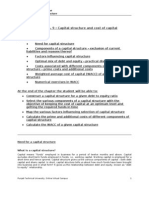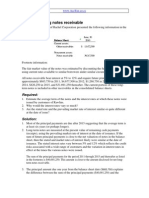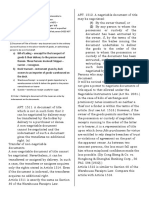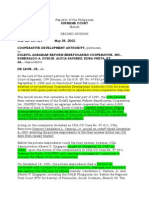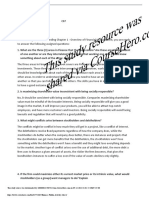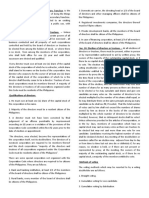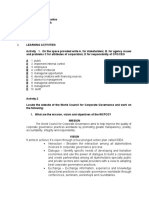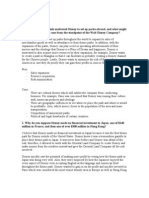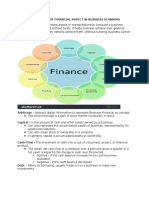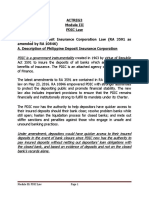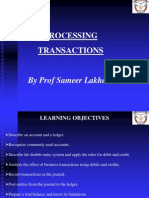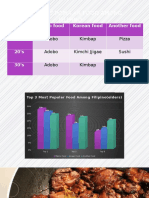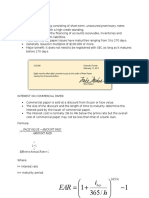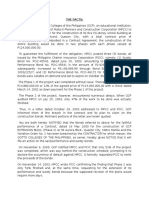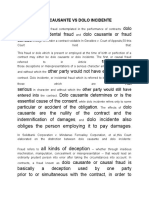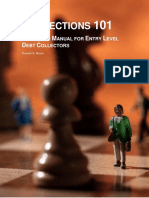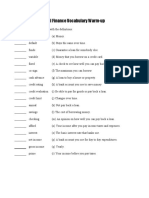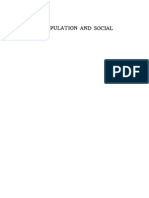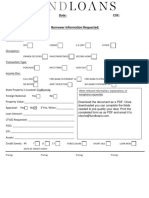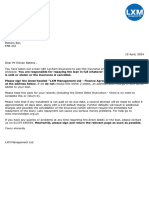0 ratings0% found this document useful (0 votes)
107 viewsFinman
Finman
Uploaded by
Karen LaccayThis document discusses various unsecured sources of short-term financing for businesses, including bank loans and commercial paper. It provides details on different types of bank loans like single-payment notes, lines of credit, and revolving credit agreements. It also discusses how interest rates on loans are determined, including fixed-rate versus floating rates. Commercial paper is described as another source of short-term financing available mainly to large companies. International loans are used to finance international transactions and involve additional foreign exchange risks.
Copyright:
© All Rights Reserved
Available Formats
Download as DOCX, PDF, TXT or read online from Scribd
Finman
Finman
Uploaded by
Karen Laccay0 ratings0% found this document useful (0 votes)
107 views3 pagesThis document discusses various unsecured sources of short-term financing for businesses, including bank loans and commercial paper. It provides details on different types of bank loans like single-payment notes, lines of credit, and revolving credit agreements. It also discusses how interest rates on loans are determined, including fixed-rate versus floating rates. Commercial paper is described as another source of short-term financing available mainly to large companies. International loans are used to finance international transactions and involve additional foreign exchange risks.
Original Description:
financial management
Original Title
finman
Copyright
© © All Rights Reserved
Available Formats
DOCX, PDF, TXT or read online from Scribd
Share this document
Did you find this document useful?
Is this content inappropriate?
This document discusses various unsecured sources of short-term financing for businesses, including bank loans and commercial paper. It provides details on different types of bank loans like single-payment notes, lines of credit, and revolving credit agreements. It also discusses how interest rates on loans are determined, including fixed-rate versus floating rates. Commercial paper is described as another source of short-term financing available mainly to large companies. International loans are used to finance international transactions and involve additional foreign exchange risks.
Copyright:
© All Rights Reserved
Available Formats
Download as DOCX, PDF, TXT or read online from Scribd
Download as docx, pdf, or txt
0 ratings0% found this document useful (0 votes)
107 views3 pagesFinman
Finman
Uploaded by
Karen LaccayThis document discusses various unsecured sources of short-term financing for businesses, including bank loans and commercial paper. It provides details on different types of bank loans like single-payment notes, lines of credit, and revolving credit agreements. It also discusses how interest rates on loans are determined, including fixed-rate versus floating rates. Commercial paper is described as another source of short-term financing available mainly to large companies. International loans are used to finance international transactions and involve additional foreign exchange risks.
Copyright:
© All Rights Reserved
Available Formats
Download as DOCX, PDF, TXT or read online from Scribd
Download as docx, pdf, or txt
You are on page 1of 3
UNSECURED SOURCES OF SHORT TERM LOAN
2 MAJOR SOURCES: banks and sales of commercial
paper.
These are negotiated and result from action taken by the
firms financial manager. Bank loan are more popular
because they are available to firms of all sizes;
commercial paper tends to be available only to large
firms. International loans to finance international
transaction.
BANK LOANS- the major type of loan made by bank to
business is the short term, self-liquidating loan.
Short-term, self-liquidating loan an unsecured shortterm loan in which the use to which the borrowed money
is put provides the mechanism through which the loan is
repaid.
These loans are intended merely to carry the firm
through seasonal peaks in financing needs that are due
primarily to buildup of inventory and accounts receivable.
Generally, the increment above the prime rate will be
lower on a floating-rate loan than on a fixed-rate loan of
equivalent risk because the lender bears less risk with a
floating-rate loan. As a result of the volatile nature of the
prime rate during recent years, today most short-term
business loans are floating-rate loans.
Method of Computing Interest
If interest is paid at maturity, the effective (or true) annual
rate the actual rate of interest paidfor an assumed
1-year period is equal to
When interest is paid in advance, it is deducted from the
loan so that the borrower actually receives less money
than is requested (and less than they must repay).
Loans on which interest is paid in advance are called
discount loans. The effective annual rate for a discount
loan, assuming a 1-year period, is calculated as
interest
amount borrowesinterest .
Banks lend unsecured, short-term funds in three basic
ways: through single-payment notes, lines of credit, and
revolving credit agreements.
LOAN INTEREST RATE- interest rate can be fixed or
floating rate, typically based on the prime rate of interest.
The prime rate of interest (prime rate) is the lowest rate
of interest charged by leading banks on business loans
to their most important business borrowers.
Banks generally determine the rate to be charged to
various borrowers by adding a premium to the prime rate
to adjust it for the borrowers riskiness.
Wooster Company, a manufacturer of athletic apparel,
wants to borrow $10,000 at a stated annual rate of 10%
interest for 1 year. If the interest on the loan is paid at
maturity, the firm will pay $1,000 (0.10 $10,000) for the
use of the $10,000 for the year. At the end of the year,
Wooster will write a check to the lender for $11,000,
consisting of the $1,000 interest as well as the return of
the $10,000 principal. Substituting into Equation 16.3
reveals that the effective annual rate is therefore
1000
10000 =10%
Fixed-rate loan=A loan with a rate of interest that is
determined at a set increment above the prime rate and
remains unvarying until maturity.
Floating-rate loan the increment above the prime rate
is initially established, and the rate of interest is allowed
to float, or vary, above prime as the prime rate varies
until maturity.
If the money is borrowed at the same stated annual rate
for 1 year but interest is paid in advance, the firm still
pays $1,000 in interest, but it receives only $9,000
($10,000 $1,000). The effective annual rate in this case
is
Bank
A
(Fixedrate
note)
Prime
rate
Increment
Rate
charged
over the
90 days
Bank B (Floating-rate note)
1000
100001000 =11.1%
Single-payment note-A short-term, one-time loan made
to a borrower who needs funds for a specific purpose for
a short period.
6%
6%
1
1/2 %
7
1/2 %
interest
amount borrowed
1%
7% (initially)
The instrument is note. Signed by the borrower, that
states the terms of the loan, including the length of the
loan and interest rate. Maturity of 30 to 9 months or
more.
Example #1 (loan interest rates)
Gordon manufacturing, a producer of rotary mower
blades, recently borrowed $100,000 from each of 2
banks - bank A and B. The loans were incurred on the
same day, when the prime rate of interest was 6%. Each
loan involved a 90-day note
with interest to be paid at the end of 90 days. The
interest rate was set at 1 1/2% above the prime rate on
bank a's fixed-rate note. Bank B set the interest rate at
1% above the prime rate on its floating-rate note.
Bank A
Total Interest Cost = $100,000 [7 1/2% (90365)] =
$1,849
90-day rate = $1,849 $100,000 = 1.85%
Effective annual rate = (1 + 0.0185) ^4.06 - 1 = 1.0773 1 = 0.0773 = 7.73%
Bank B
For instance:
Prime rate
Interest rate
(computation)
Interest
Rate
First 30
days
6% + 1%
increment
7% (30/365)
0.575%
After 30
days
6.5 % (+ 1%
increment
7.5% (30/365)
After 30
days
6.25% (+ 1%
increment)
7.25% (30/365) 0.596%
Total
Interest
rate
0.616%
1.787%
Total interest cost = $100,000 1.787% = $1787
90-day rate = $1787 $100,000 = 1.79%
effective annual rate = (1 + 0.01787) ^4.06 - 1 = 1.0746 1 = 0.0746 = 7.46%
example (loan interest rates)
Megan Schwartz has been approved by Clinton national
bank for a 180-day loan of $30,000 that will allow her to
make the down payment and close the loan on her new
condo. She needs the funds to bridge the time until the
sale of her current condo, from which she expects to
receive $42,000.
Clinton national offered Megan the following two
financing options for the $30,000 loan: (1) a fixed rate
loan at 2% above the prime rate or (2) a variable rate
loan at 1% above the prime rate. Currently, the prime
rate of interest is 8% and the consensus forecast of the
group of mortgage economists for changes in the prime
rate over the next 180 days is as follows:
60 days from today the prime rate will rise by 1%
90 days from today the prime rate will rise another 1/2%
150 days from today the prime rate will drop by 1%
Fixed-rate Loan : Total Interest cost over 180 days
= $30,000 (0.08 + 0.02) (180/365)
= $30,000 0.04932
= $1,480
Variable-rate Loan : Total interest cost over 180 days
=$30,000 [(0.09 60/365) + (0.10 30/365) + (0.105
60/365) + (0.095 30/365)]
=$30,000 (0.01479+0.00822+0.01726+0.00781)
=$30,000 0.04808
=$1,442
LINE OF CREDIT- an agreement between a commercial
bank and a business specifying the amount of
unsecured short term borrowing the bank will make
available to the firm over a given period of time.
It is not a guaranteed loan but indicates that if the bank
has sufficient funds available, it will allow the borrower to
owe it up to a certain amount of money. The amount of a
line of credit is the maximum amount the firm can owe
the bank at any point in time.
Interest Rates- the interest rate on line of credit is
normally stated as a floating rate- the prime rate plus a
premium. The more creditworthy the borrower, the lower
the premium (interest increment) above prime, and vice
versa.
Operating-change restrictions Contractual restrictions
that a bank may impose on a firms financial condition or
operations as part of a line-of- credit agreement.
Compensating Balances To ensure that the borrower
will be a good customer, many short-term unsecured
bank loanssingle-payment notes and lines of credit
require the borrower to maintain, in a checking account,
a
Compensating balance equal to a certain percentage of
the amount borrowed.
Revolving Credit Agreements-is nothing more than a
guaranteed line of credit.
The commercial bank assures the borrower that
specified amount of funds will be made available
regardless of the scarcity of money.
A commitment fee is a banking term used to describe
a fee charged by a lender to a borrower to compensate
the lender for its commitment to lend. Commitment fees
are typically associated with unused credit lines or
undisbursed loans.
-Normally it is .5% of the average unused portion of the
credit line.
Commercial paper is a form of financing that
consists of short-term, unsecured promissory notes
issued by firms with a high credit standing. Generally,
only large firms of unquestionable financial soundness
are able to issue commercial paper. Most commercial
paper issues have maturities ranging from 3 to 270 days.
Interest on commercial paper is sold at discount from
its par, or face, value. The size of the discount and
length of time to maturity determine the interest paid by
the issuer of commercial paper.
Example:
Bertram Corporation, a large shipbuilder, has just issued
$1 million worth of commercial paper that has a 90-day
maturity and sells for $990,000. At the end of 90 days,
the purchaser of this paper will receive $1 million for its
$990,000 investment. The interest paid on the financing
is therefore $10,000 on a principal of $990,000. The
effective 90-day rate on the paper is 1.01%
($10,000/$990,000). Assuming that the paper is rolled
over each 90-days throughout the year (that is 365/90 =
4.06 times per year), the effective annual rate for
Bertrams commercial paper is 4.16% [(1+0.0101)4.06-
1].
INTERNATIONAL LOAN/ TRANSACTION- the
important difference between international and domestic
transactions is that payments are often made or received
in a foreign currency. Not only must a U.S. company pay
the costs of doing business in the foreign exchange
market, but it also is exposed to exchange rate risk.
Although exchange rate risk can often be hedged by
using currency forward, futures, or options markets,
doing so is costly and is not possible for all foreign
currencies.
Typical international transactions are large in size and
have long maturity dates. Therefore, companies that are
involved in international trade generally have to finance
larger dollar amounts for longer time periods than
companies that operate domestically.
Financing International Trade=Perhaps the most
important financing vehicle is the letter of credit, a letter
written by a companys bank to the companys foreign
supplier, stating that the bank guarantees payment of an
invoiced amount if all the underlying agreements are
met. The Eurocurrency loan markets allow creditworthy
borrowers to obtain financing on attractive terms.
Transactions between Subsidiaries-the parent can
minimize foreign exchange fees and other transaction
costs by netting what affiliates owe each other and
paying only the net amount due, rather than having both
subsidiaries pay each other the gross amounts due.
You might also like
- Motion Calls For Seizing of Kouri Richins Assets Under Utah's "Slayer Statute"Document255 pagesMotion Calls For Seizing of Kouri Richins Assets Under Utah's "Slayer Statute"KUTV 2News100% (1)
- Capital Markets Chapter 3Document11 pagesCapital Markets Chapter 3Faith FajarilloNo ratings yet
- The Roles of Financial Market and Financial InstitutionsDocument4 pagesThe Roles of Financial Market and Financial InstitutionstssuvroNo ratings yet
- The Financial Plan: Serjoe Orven Gutierrez - Mmed ReporterDocument41 pagesThe Financial Plan: Serjoe Orven Gutierrez - Mmed ReporterSerjoe GutierrezNo ratings yet
- Financial Management - Chapter 9Document17 pagesFinancial Management - Chapter 9mechidreamNo ratings yet
- Philippine Debt FPVICLARDocument15 pagesPhilippine Debt FPVICLARenaportillo13No ratings yet
- Notes ReceivableDocument1 pageNotes ReceivableJohn Carlo Lorenzo75% (4)
- Interest-Bearing Notes ReceivableDocument2 pagesInterest-Bearing Notes Receivablewarsidi100% (1)
- Source of CapitalDocument10 pagesSource of Capitalrenatus APOLINARYNo ratings yet
- A Study On The Sales PromotionalDocument66 pagesA Study On The Sales PromotionalkalaivaniNo ratings yet
- Bankrupty Liquidation and ReorDocument31 pagesBankrupty Liquidation and ReorLuke Robert HemmingsNo ratings yet
- PART I: The Company's Current CSR PictureDocument32 pagesPART I: The Company's Current CSR PictureWhella BacaycayNo ratings yet
- Law Art 1511 - 1525Document14 pagesLaw Art 1511 - 1525zcel delos ReyesNo ratings yet
- Security Types Security Types: Fundamentals InvestmentsDocument27 pagesSecurity Types Security Types: Fundamentals InvestmentsadillawaNo ratings yet
- Accounting 3Document20 pagesAccounting 3Nigussie BerhanuNo ratings yet
- Lesson 6 - CreditDocument52 pagesLesson 6 - CreditDianne Joy MempinNo ratings yet
- BUSINESS FINANCE - BDO BankDocument11 pagesBUSINESS FINANCE - BDO BankCarmela Isabelle DisilioNo ratings yet
- Calculating The Cost of CapitalDocument2 pagesCalculating The Cost of CapitalCyrine Miwa RodriguezNo ratings yet
- Private Insurance CompaniesDocument73 pagesPrivate Insurance CompaniesRoselle OngNo ratings yet
- Module 2-Receivables ManagementDocument36 pagesModule 2-Receivables Managementgaurav shettyNo ratings yet
- Reniel A. Agito BSN 1-Y2-2 Instruction: Take A Few Minutes To Think and Write Your Thoughts About The Lecture Discussion QuestionDocument2 pagesReniel A. Agito BSN 1-Y2-2 Instruction: Take A Few Minutes To Think and Write Your Thoughts About The Lecture Discussion QuestionRENIEL AGITONo ratings yet
- Admin Law. Cooperative Development Authority v. Delfin Agrarian BeneficiariDocument20 pagesAdmin Law. Cooperative Development Authority v. Delfin Agrarian Beneficiariiceiceice023100% (1)
- Emnace FinMa Activity 2Document2 pagesEmnace FinMa Activity 2CASTOR, Vincent PaulNo ratings yet
- BDO Products and ServicesDocument3 pagesBDO Products and ServicesPaulineBiroselNo ratings yet
- Sources of Credit InformationDocument2 pagesSources of Credit InformationR100% (1)
- Module Two: Theories of International Trade: Part OneDocument16 pagesModule Two: Theories of International Trade: Part OneitsmenatoyNo ratings yet
- GGSRDocument14 pagesGGSRCarmela DimaalihanNo ratings yet
- Bank ReserveDocument11 pagesBank ReserveNicole Ocampo100% (1)
- Details About The Cebu PacificDocument12 pagesDetails About The Cebu PacificVctr MrlsNo ratings yet
- Tutorial 1: 1. What Is The Basic Functions of Financial Markets?Document6 pagesTutorial 1: 1. What Is The Basic Functions of Financial Markets?Ramsha ShafeelNo ratings yet
- Inventories With Lower Cost, Without Sacrificing Its QualityDocument4 pagesInventories With Lower Cost, Without Sacrificing Its QualityMark Lyndon YmataNo ratings yet
- Commercial Bank PDFDocument22 pagesCommercial Bank PDFA ThakurNo ratings yet
- Sec. 23. The Board of Directors or Trustees. - UnlessDocument8 pagesSec. 23. The Board of Directors or Trustees. - UnlessCheivy SolimanNo ratings yet
- Chapter 11Document50 pagesChapter 11Randi ZamrajjasaNo ratings yet
- Discounting Notes ReceivableDocument3 pagesDiscounting Notes ReceivablerockerNo ratings yet
- Recommendation RCBCDocument2 pagesRecommendation RCBCTrisha Cabral0% (1)
- MGT-4 Modules 1-5Document15 pagesMGT-4 Modules 1-5RHIAN B.No ratings yet
- Defining The 3 Types of InvestmentsDocument3 pagesDefining The 3 Types of InvestmentsJackieNo ratings yet
- New Venture Financing Lecture Note (Ch-2)Document30 pagesNew Venture Financing Lecture Note (Ch-2)Beamlak100% (2)
- International Business hw1Document3 pagesInternational Business hw1Zbw88No ratings yet
- Is Your Home GlobalizedDocument17 pagesIs Your Home GlobalizedJram MarjNo ratings yet
- Chap9 (Cash & Marketable Securities Management) VanHorne&Brigham, CabreaDocument4 pagesChap9 (Cash & Marketable Securities Management) VanHorne&Brigham, CabreaClaudine DuhapaNo ratings yet
- Importance of Financial Aspect in Business PlanningDocument2 pagesImportance of Financial Aspect in Business PlanningclsNo ratings yet
- Types of Bank: Lima, Camille Jane L. Prof. Cesar Cruel 3-FM5 MW 4:00-5:30 PMDocument4 pagesTypes of Bank: Lima, Camille Jane L. Prof. Cesar Cruel 3-FM5 MW 4:00-5:30 PMcamille janeNo ratings yet
- Metrobank Research 1 To 5Document36 pagesMetrobank Research 1 To 5Mark Joaquin AlcalaNo ratings yet
- Understanding Interest RatesDocument9 pagesUnderstanding Interest RatesLM FernandezNo ratings yet
- Juridical PersonDocument7 pagesJuridical Personrovi diosoNo ratings yet
- Module III PDIC LawDocument10 pagesModule III PDIC LawChristine ViernesNo ratings yet
- Processing Transactions: by Prof Sameer LakhaniDocument83 pagesProcessing Transactions: by Prof Sameer LakhaniBhagyashree JadhavNo ratings yet
- Credit & Collection + Capital MarketDocument8 pagesCredit & Collection + Capital MarketMilky CoffeeNo ratings yet
- Fraud in The PhilippinesDocument2 pagesFraud in The PhilippinesJessa Caberte100% (1)
- Hybrid Finance - EssayDocument6 pagesHybrid Finance - EssayMalina TatarovaNo ratings yet
- Business Laws and Organizations Basic Type of Business OrganizationsDocument7 pagesBusiness Laws and Organizations Basic Type of Business OrganizationsYuki BarracaNo ratings yet
- Receivable ManagementDocument2 pagesReceivable ManagementR100% (1)
- Capitalization in Finance: OvercapitalizationDocument3 pagesCapitalization in Finance: OvercapitalizationRohit Bajpai100% (1)
- Financial Market StructureDocument17 pagesFinancial Market StructureVishnu Pathak100% (1)
- Chapter OneDocument119 pagesChapter Onegary galangNo ratings yet
- Investment in BondsDocument14 pagesInvestment in BondsJoe GarciaNo ratings yet
- Review Question 2-1Document2 pagesReview Question 2-1Wilson Yao67% (3)
- What Are The Types of Business Organization? Differentiate EachDocument3 pagesWhat Are The Types of Business Organization? Differentiate EachCarmelle BahadeNo ratings yet
- Top 3 Most Popular Food Among Filipino: Age Filipino Food Korean Food Another Food 10's 20's 30'sDocument26 pagesTop 3 Most Popular Food Among Filipino: Age Filipino Food Korean Food Another Food 10's 20's 30'sKaren LaccayNo ratings yet
- The Philippine CurrencyDocument72 pagesThe Philippine CurrencyKaren LaccayNo ratings yet
- Background Information2Document6 pagesBackground Information2Karen Laccay50% (2)
- Fraud in Marriage-HomosexualityDocument3 pagesFraud in Marriage-HomosexualityKaren LaccayNo ratings yet
- Commercial PaperDocument2 pagesCommercial PaperKaren Laccay100% (6)
- ABL 1 - University of CordilleraDocument3 pagesABL 1 - University of CordilleraKaren LaccayNo ratings yet
- Dolo Causante Vs Dolo IncidenteDocument4 pagesDolo Causante Vs Dolo IncidenteKaren LaccayNo ratings yet
- Finman 1Document18 pagesFinman 1Karen LaccayNo ratings yet
- Revised Case DigestDocument5 pagesRevised Case DigestKaren LaccayNo ratings yet
- Breach of ContractDocument13 pagesBreach of ContractKaren LaccayNo ratings yet
- Filipino Food Korean FoodDocument3 pagesFilipino Food Korean FoodKaren LaccayNo ratings yet
- A Survey Questionnaire of Filipino FoodDocument2 pagesA Survey Questionnaire of Filipino FoodKaren Laccay100% (1)
- SipDocument79 pagesSipGangani PinalNo ratings yet
- U5 Risk-Management-Case StudyDocument8 pagesU5 Risk-Management-Case StudyK.SHARVESH 22IH08No ratings yet
- Chapter 8 - Sources of Business FinanceDocument10 pagesChapter 8 - Sources of Business Financerudransh singhNo ratings yet
- MCQ - Specimen BDocument12 pagesMCQ - Specimen Bcharlax17No ratings yet
- Bank - WikipediaDocument38 pagesBank - WikipediaShruthi AmmuNo ratings yet
- Financial Literacy Test Grade 11 Entrepreneurship Mr. Valley Student NameDocument8 pagesFinancial Literacy Test Grade 11 Entrepreneurship Mr. Valley Student Nameapi-350400617No ratings yet
- IN20230920002692 - Application FormDocument12 pagesIN20230920002692 - Application FormHenna Nizar AhammedNo ratings yet
- Bank Concentration, Competition, and Financial Inclusion: SciencedirectDocument17 pagesBank Concentration, Competition, and Financial Inclusion: SciencedirectMatheus RibeiroNo ratings yet
- Samoorthy 1Document23 pagesSamoorthy 1NadarajNo ratings yet
- Investment Policy of BankDocument40 pagesInvestment Policy of BankPrakash BhandariNo ratings yet
- 10 - Chapter 2Document23 pages10 - Chapter 2Task MastersNo ratings yet
- UCPB Vs Sps BelusoDocument19 pagesUCPB Vs Sps BelusoNicoleAngeliqueNo ratings yet
- An Study On Commercial Banks of Ethiopia: Determinants of Nonperforming Loan: EmpiricalDocument109 pagesAn Study On Commercial Banks of Ethiopia: Determinants of Nonperforming Loan: EmpiricalMAHLET ZEWDENo ratings yet
- Collections 101 PDFDocument229 pagesCollections 101 PDFJon C. McGahan100% (1)
- Personal Finance Vocabulary Warm-UpDocument3 pagesPersonal Finance Vocabulary Warm-UpSamuel MakikuNo ratings yet
- KRSE - B - 15-20HP-115PSI-230V - 20HP-115PSI-460V-SKK55 Parts Manual - 97002015000020BDocument41 pagesKRSE - B - 15-20HP-115PSI-230V - 20HP-115PSI-460V-SKK55 Parts Manual - 97002015000020BRogelio MirelesNo ratings yet
- Rev. Denis Fahey - Money Manipulation and Social OrderDocument115 pagesRev. Denis Fahey - Money Manipulation and Social OrderAnonymous HtDbszqtNo ratings yet
- 3rd Partnership (Obli of Partners Among Themselves) PDFDocument169 pages3rd Partnership (Obli of Partners Among Themselves) PDFAllen BalangueNo ratings yet
- (1281985908) 1st Choice Insurance New Business LetterDocument14 pages(1281985908) 1st Choice Insurance New Business Letterifrimgeorge89No ratings yet
- RBI Master CircularDocument42 pagesRBI Master CircularDeep Singh PariharNo ratings yet
- Vivifi India Finance PVT LTDDocument5 pagesVivifi India Finance PVT LTDRamesh yaraboluNo ratings yet
- Vaibhav (Banking and Insurance) - 1Document10 pagesVaibhav (Banking and Insurance) - 1Vaibhav TiwariNo ratings yet
- Corporate Banking 1Document34 pagesCorporate Banking 1Pravah ShuklaNo ratings yet
- Buy SendGrid AccountsDocument6 pagesBuy SendGrid AccountsGuillermo HolmesNo ratings yet
- Exercise InterestDocument1 pageExercise InterestimlanglavangNo ratings yet
- FUNDLOANS Pre-QualificationDocument1 pageFUNDLOANS Pre-QualificationChristopher LeoneNo ratings yet
- Naziya Bank of BarodaDocument72 pagesNaziya Bank of Barodaaadil shaikhNo ratings yet
- Module 2 Packet: AE 19 - Financial ManagementDocument10 pagesModule 2 Packet: AE 19 - Financial ManagementEddie Mar JagunapNo ratings yet
- LXM Finance AgreementDocument10 pagesLXM Finance Agreementfaninhalemes25No ratings yet




